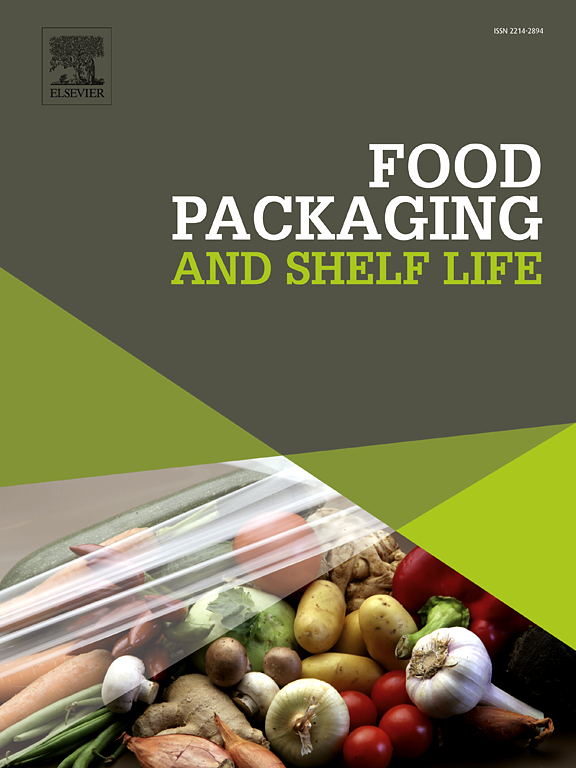Development and characterisation of polylactic acid/cinnamon bark oil films: Phenolic migration into various food simulants
IF 8.5
1区 农林科学
Q1 FOOD SCIENCE & TECHNOLOGY
引用次数: 0
Abstract
In this study, polylactic acid (PLA)/cinnamon bark oil (CBO) films were prepared via solvent casting method and characterised for their physical, optical, mechanical, and antioxidant properties. A 15 % loading of CBO significantly (p < 0.05) improved the water vapour barrier, tensile strength, and elongation at break, while its effects on film thickness and water solubility were insignificant (p ≥ 0.05). At a 30 % CBO concentration, the films exhibited over 99 % UV light blockage at wavelengths of 200, 280, and 400 nm. Antioxidant assays demonstrated strong radical scavenging activities, with maximum DPPH and ABTS scavenging values of 93.30 % and 99.40 %, respectively. Controlled phenolic migration studies were conducted using aqueous (10 % ethanol), lipophilic (50 % ethanol), and acidic (3 % acetic acid solution) food simulants to investigate the behaviour of the PLA/CBO film and their antioxidant activities in various food systems. The migration results followed an exponential time-dependent trend, with the highest migration in 50 % ethanol, indicating the films’ efficacy in preventing oxidative deterioration in fatty foods. These findings demonstrate the potential of PLA/CBO films as active and sustainable packaging materials, offering enhanced barrier, mechanical, and antioxidant properties compared to pure PLA films, making them promising candidates for reducing food waste and extending product shelf life.
聚乳酸/肉桂皮油膜的研制与表征:酚类物质在各种食品模拟剂中的迁移
本研究采用溶剂浇铸法制备了聚乳酸(PLA)/肉桂皮油(CBO)薄膜,并对其物理、光学、机械和抗氧化性能进行了表征。添加15% %的CBO (p <; 0.05)显著提高了薄膜的水蒸气阻隔性、拉伸强度和断裂伸长率,而对薄膜厚度和水溶性的影响不显著(p ≥ 0.05)。当CBO浓度为30 %时,膜在200、280和400 nm波长处表现出99% %以上的紫外光阻挡。抗氧化试验显示出较强的自由基清除活性,DPPH和ABTS的最大清除值分别为93.30 %和99.40 %。采用含水(10 %乙醇)、亲脂(50 %乙醇)和酸性(3 %乙酸溶液)食物模拟剂进行对照酚类迁移研究,以研究PLA/CBO薄膜在各种食物体系中的行为及其抗氧化活性。迁移结果呈指数时间依赖趋势,在50% %乙醇中迁移量最大,表明膜在防止脂肪食品氧化变质方面的功效。这些发现证明了PLA/CBO薄膜作为活性和可持续包装材料的潜力,与纯PLA薄膜相比,它具有增强的阻隔、机械和抗氧化性能,使其成为减少食物浪费和延长产品保质期的有希望的候选材料。
本文章由计算机程序翻译,如有差异,请以英文原文为准。
求助全文
约1分钟内获得全文
求助全文
来源期刊

Food Packaging and Shelf Life
Agricultural and Biological Sciences-Food Science
CiteScore
14.00
自引率
8.80%
发文量
214
审稿时长
70 days
期刊介绍:
Food packaging is crucial for preserving food integrity throughout the distribution chain. It safeguards against contamination by physical, chemical, and biological agents, ensuring the safety and quality of processed foods. The evolution of novel food packaging, including modified atmosphere and active packaging, has extended shelf life, enhancing convenience for consumers. Shelf life, the duration a perishable item remains suitable for sale, use, or consumption, is intricately linked with food packaging, emphasizing its role in maintaining product quality and safety.
 求助内容:
求助内容: 应助结果提醒方式:
应助结果提醒方式:


